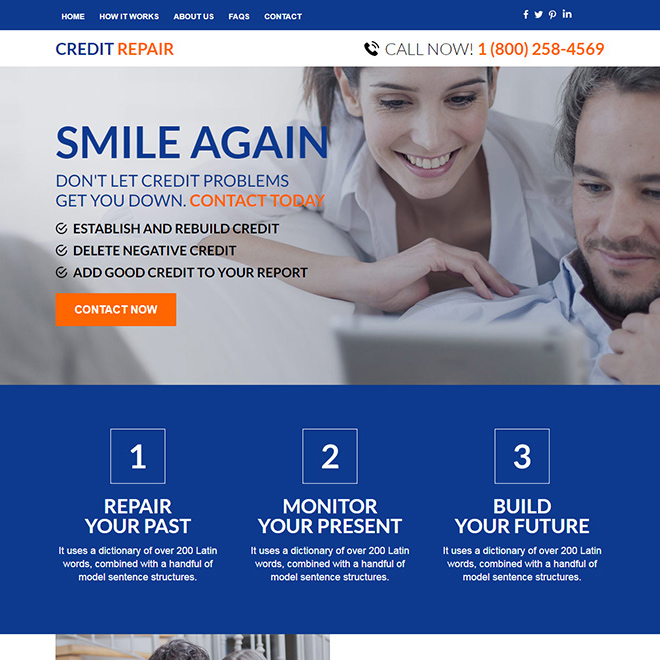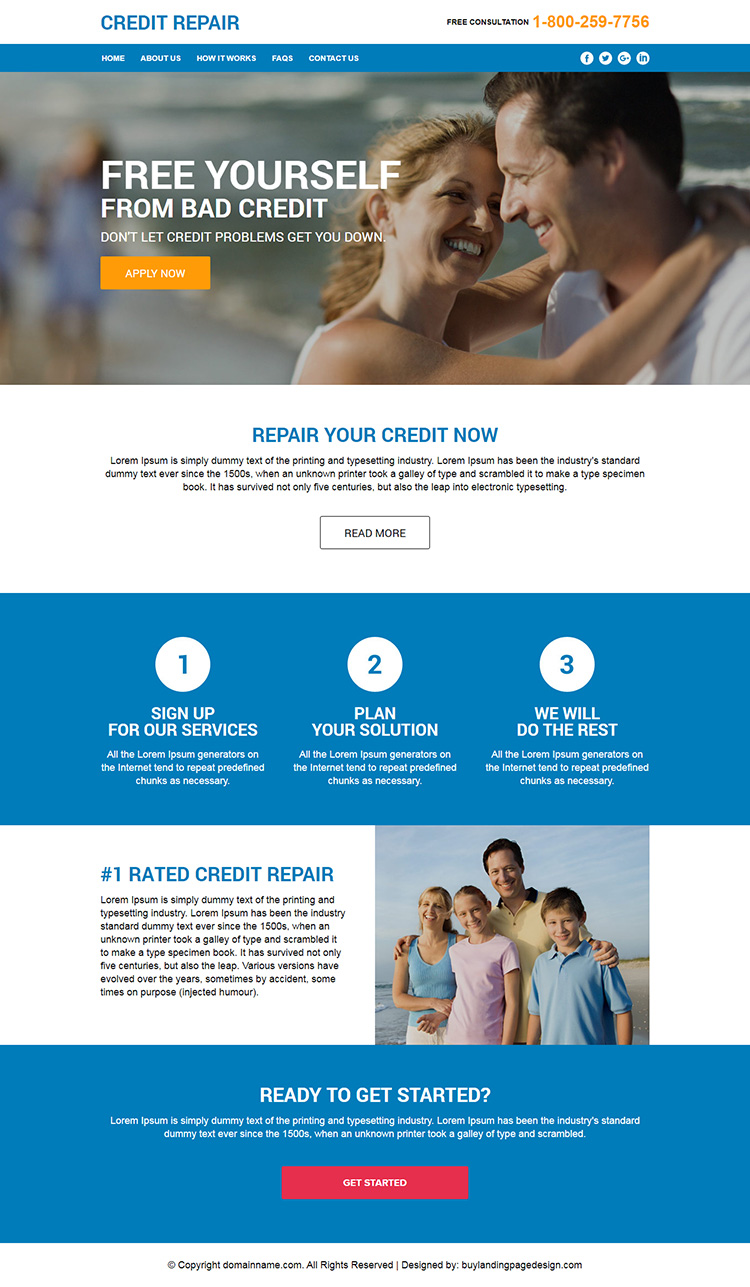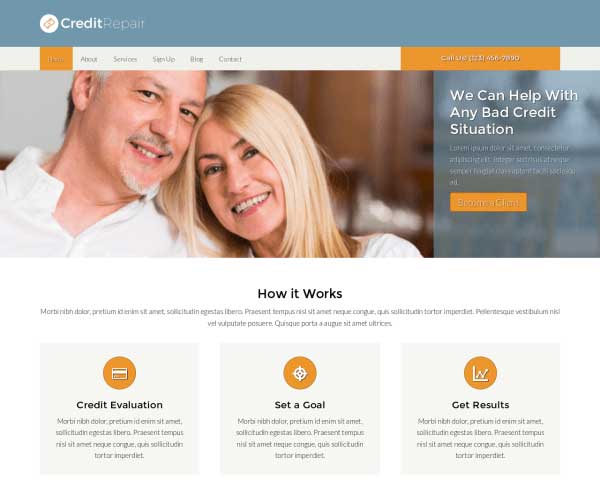So you’re in need of a credit repair website template? Look no further! This article has all the information you need to create an eye-catching and effective website for your credit repair business. Whether you’re just starting out or looking to revamp your existing site, this template will provide you with the perfect foundation. From customizable layouts to engaging content, you’ll have everything you need to attract and convert visitors into loyal customers. Say goodbye to complicated design processes and say hello to a user-friendly and visually stunning credit repair website.
1. Importance of Having a Credit Repair Website
1.1 Establishing Credibility
Having a credit repair website is essential for establishing credibility in the industry. When potential clients are searching for credit repair services, they often turn to the internet to find reputable companies. By having a professional and informative website, you can showcase your expertise and build trust with potential clients. A well-designed website can give your business a polished and trustworthy image, making it more likely for potential clients to choose your services.
1.2 Attracting Potential Clients
A credit repair website is a powerful tool for attracting potential clients. With the majority of people using the internet to research services before making a decision, having a strong online presence is crucial. Your website can act as a marketing platform, showcasing the services you offer and highlighting the benefits of choosing your company. By optimizing your website for search engines, you can increase your visibility online and attract a steady stream of potential clients who are actively seeking credit repair services.
1.3 Providing Information and Resources
A credit repair website allows you to provide valuable information and resources to your clients. By including educational content on your website, such as articles and blog posts about credit repair tips and strategies, you can position yourself as a trusted source of information in the industry. This not only helps potential clients make informed decisions, but it also establishes your expertise and credibility as a credit repair professional. Additionally, you can include resources such as FAQs and guides to assist clients in understanding the credit repair process.
2. Design and Layout Considerations
2.1 User-Friendly Navigation
When designing your credit repair website, it is important to focus on creating a user-friendly navigation system. Your website should be easy to navigate, with clear and intuitive menus that allow visitors to find the information they need quickly and easily. Consider using drop-down menus, breadcrumbs, and search functionality to enhance navigation. By making it effortless for visitors to find the information they are looking for, you can improve their overall browsing experience and increase the chances of converting them into clients.
2.2 Professional and Trustworthy Design
The design of your credit repair website plays a crucial role in establishing trust with potential clients. Aim for a professional and trustworthy design that reflects the seriousness and reliability of your business. Use high-quality images, clear typography, and a clean layout to create a visually appealing website. Avoid clutter and excessive use of colors or graphics that may distract from the main message. By creating a polished and professional design, you can instill confidence in your visitors and make a positive first impression.
2.3 Mobile Responsiveness
In today’s mobile-driven world, it is essential to ensure that your credit repair website is mobile-responsive. With a significant portion of internet users accessing websites through mobile devices, a mobile-responsive design is crucial for providing an optimal user experience. Your website should automatically adjust to different screen sizes and resolutions, ensuring that it remains readable and visually appealing on smartphones and tablets. By prioritizing mobile responsiveness, you can reach a wider audience and cater to the needs of potential clients who prefer browsing on their mobile devices.

3. Key Features to Include in a Credit Repair Website
3.1 Sign-Up and Contact Forms
Including sign-up and contact forms on your credit repair website allows potential clients to easily get in touch with you. These forms should be prominently placed on your website, making it convenient for visitors to reach out and inquire about your services. By capturing their contact information, you can follow up with potential clients and guide them through the credit repair process. Ensure that the forms are user-friendly, with clear instructions and fields for relevant information such as name, email, and phone number.
3.2 Testimonials and Success Stories
Testimonials and success stories are powerful tools for building trust and credibility. Including a dedicated section on your credit repair website where you showcase testimonials from satisfied clients can help potential clients feel confident in choosing your services. Aim for a diverse range of testimonials, including both written testimonials and video testimonials if possible. These testimonials should highlight the positive impact your credit repair services have had on clients’ lives and demonstrate the effectiveness of your strategies.
3.3 Services and Pricing Information
Clearly outlining the services you offer and their corresponding pricing on your website is essential for transparency and clarity. Potential clients should be able to easily understand the options available to them and the associated costs. Consider breaking down your services into different packages or tiers to cater to different client needs. Ensure that the pricing information is easily accessible and prominently displayed on your website to avoid any confusion or surprises for potential clients.
3.4 Educational Content
Educational content is a valuable addition to any credit repair website. By providing informative articles, blog posts, and resources related to credit repair, you can position yourself as an authority in the field and establish trust with potential clients. Your educational content can cover topics such as understanding credit reports, improving credit scores, dealing with debt, and other relevant information. Aim to provide practical tips and actionable advice that potential clients can benefit from.
3.5 FAQs Section
Including a frequently asked questions (FAQs) section on your credit repair website can address common queries and concerns that potential clients may have. This section should cover a wide range of topics related to credit repair, such as the timeframe for results, the process involved, and any legal considerations. By providing clear and concise answers to frequently asked questions, you can save potential clients time and provide them with the information they need to make informed decisions.
4. Customization Options for Your Credit Repair Website
4.1 Branding and Color Scheme
Customizing the branding and color scheme of your credit repair website is crucial for establishing a consistent and memorable brand identity. Your website should reflect your brand’s colors, logo, and overall visual aesthetic. Consistency throughout your website helps build recognition and reinforces your brand image in the minds of potential clients. Choose colors that align with your brand’s personality and values, and ensure that they complement each other to create a visually pleasing and cohesive design.
4.2 Customizable Templates
Opting for a credit repair website template that offers customization options can save you time and effort in building your website. Look for templates that allow you to easily modify the layout, colors, fonts, and other design elements to match your branding. Customizable templates give you the flexibility to create a unique website that reflects your company’s personality and style. Ensure the template you choose is user-friendly and allows you to make changes without requiring extensive coding knowledge.
4.3 Integration with CRM Systems
Integrating your credit repair website with customer relationship management (CRM) systems can streamline your client management processes. CRM software allows you to manage client information, track interactions, and automate tasks such as sending follow-up emails or reminders. When selecting a website template or building your website, ensure that it offers integration options with popular CRM systems. This integration can enhance your efficiency and help you provide personalized and timely support to your clients.

5. SEO Optimization for Credit Repair Websites
5.1 Keyword Research and Optimization
Implementing search engine optimization (SEO) strategies on your credit repair website can improve your visibility in search engine results pages. Conduct keyword research to identify the phrases and terms potential clients are using to search for credit repair services. Optimize your website’s content by using relevant keywords naturally in titles, headings, and body text. Be mindful not to overstuff keywords, as this can negatively impact user experience and search engine rankings.
5.2 Metadata and On-Page SEO
In addition to keyword optimization, pay attention to on-page SEO factors such as metadata. Customize title tags and meta descriptions to accurately describe the content of each page on your website. This helps search engines understand the relevance and purpose of your pages. Optimize your URLs, headings, and image alt tags to include keywords where appropriate. Additionally, ensure your website has a clear site structure with easy navigation to enhance crawlability for search engines.
5.3 Link Building and Backlinks
Building high-quality backlinks from reputable websites is an important aspect of SEO for credit repair websites. Look for opportunities to collaborate with other industry professionals, such as guest blogging or participating in interviews or podcasts. Create valuable and shareable content that others find useful and would be willing to link to. Engage in social media platforms to promote your content and attract natural backlinks. Building a strong backlink profile can increase your website’s authority and improve its ranking in search engine results.
6. Ensuring Legal Compliance in Your Credit Repair Website
6.1 Understanding Credit Repair Laws
When operating a credit repair website, it is crucial to ensure compliance with applicable credit repair laws and regulations. Familiarize yourself with the laws governing credit repair, such as the Credit Repair Organizations Act (CROA) in the United States. Understand the restrictions and requirements placed on credit repair companies to avoid legal issues. Seek legal advice if necessary to ensure that your website and business practices are compliant with relevant laws in your jurisdiction.
6.2 Including Disclaimers and Disclosures
To protect your business and inform potential clients, it is essential to include disclaimers and disclosures on your credit repair website. Disclaimers clarify the limitations and scope of your services, ensuring that potential clients have realistic expectations. Disclosures provide transparency about any affiliations, partnerships, or compensation you may have with other organizations or companies. These disclaimers and disclosures should be prominently displayed and easily accessible on your website.
6.3 Privacy Policy and Terms of Service
To comply with data protection regulations and establish trust with your website visitors, it is important to have a privacy policy and terms of service prominently displayed on your credit repair website. Your privacy policy should outline how you collect, use, store, and protect personal information. Your terms of service should outline the rights and responsibilities of both your business and your clients. These policies demonstrate your commitment to privacy and data security and help to establish trust with potential clients.

7. Security Measures for Credit Repair Websites
7.1 SSL Certificate and Encryption
Protecting the personal and financial information of your clients is of utmost importance for a credit repair website. Use Secure Sockets Layer (SSL) certificates to encrypt data exchanged between your website and its users. SSL certificates ensure that sensitive information such as credit card details or social security numbers cannot be intercepted by unauthorized parties. Displaying trust indicators, such as a padlock icon or the “https” prefix in your website’s URL, can reassure potential clients about the security of their data.
7.2 Regular Backups and Data Protection
Implementing regular backups of your credit repair website and client data is essential to protect against data loss or security breaches. Regularly backup your website files and databases, storing them securely in multiple locations. This precautionary measure ensures that you can restore your website and client data in the event of any unforeseen issues or attacks. Additionally, consider implementing firewalls, antivirus software, and other security measures to protect your website from malicious threats.
7.3 Protection against Cyber Attacks
Cyber attacks, such as hacking or distributed denial of service (DDoS) attacks, can disrupt your credit repair website and compromise its security. Protect your website by regularly updating its software, plugins, and themes to patch any security vulnerabilities. Monitor your website’s traffic and implement measures to detect and prevent suspicious activities. Consider investing in a web application firewall (WAF) to protect your website from malicious traffic and brute-force attacks. By staying vigilant and proactive, you can mitigate the risk of cyber attacks on your credit repair website.
8. Integrating Social Media in Your Credit Repair Website
8.1 Social Sharing Buttons
Integrating social sharing buttons on your credit repair website allows visitors to easily share your content on their social media profiles. This increases the visibility of your website and helps attract new potential clients. Place social sharing buttons strategically on your web pages, particularly on content-rich pages such as blog posts or educational articles. Ensure that the buttons are easily noticeable and provide options to share content on popular social media platforms.
8.2 Linking to Social Media Profiles
Linking to your social media profiles from your credit repair website enables visitors to learn more about your business and engage with your content. Include clickable icons or links to your social media profiles in a prominent location, such as your website’s header or footer. This allows potential clients to connect with you on platforms where they feel comfortable, and it provides an additional avenue for them to contact you or ask questions. Regularly update your social media profiles with relevant content to engage your audience and showcase your expertise.
8.3 Engaging with Clients on Social Platforms
Social media platforms offer opportunities to engage with your clients and build relationships beyond your credit repair website. Use platforms such as Facebook, Twitter, or LinkedIn to respond to client inquiries, address concerns, or share updates about your services. Engaging with your clients on social media humanizes your brand and creates a sense of community. Encourage clients to leave reviews or testimonials on your social media profiles to further enhance your credibility and attract more potential clients.

9. Recommended Credit Repair Website Templates
9.1 Template 1: Clean and Modern Design
A clean and modern design template for a credit repair website can create a professional and contemporary look. Opt for a template that utilizes whitespace effectively, making your content stand out. Choose a simple color scheme that aligns with your brand and reflects a sense of professionalism. Use high-quality images or illustrations that accentuate the modern design. Ensure the template is customizable and provides flexibility to showcase your unique branding elements.
9.2 Template 2: Professional and Elegant
For a credit repair website that exudes elegance and sophistication, select a template with a professional and refined design. Look for a layout that emphasizes clarity and readability of the content. Use elegant typography and a color palette that conveys trust and reliability. The template should allow for customization to incorporate your brand’s visual identity. Utilize high-quality imagery and consider adding subtle animations or transitions to enhance the overall elegance of the design.
9.3 Template 3: Bold and Eye-catching
A bold and eye-catching template can help your credit repair website stand out in a competitive market. Opt for a template that utilizes vibrant colors, bold typography, and impactful visual elements. Consider using parallax scrolling or interactive features to captivate visitors’ attention. Incorporate striking graphics or illustrations that support your key messages. Choose a template that allows you to highlight your services and testimonials in an engaging and visually appealing manner.
10. Best Practices for Credit Repair Website Success
10.1 Regularly Update and Optimize Content
To keep your credit repair website relevant and engaging, regularly update and optimize your content. Publish fresh blog posts or articles that address current trends, news, or legislative changes in the credit repair industry. Keep your educational resources up to date and expand your content library to provide comprehensive information to potential clients. Continuously optimize your content for search engines by identifying new keywords and improving existing content based on performance metrics and user feedback.
10.2 Monitor Website Analytics
Monitoring website analytics is crucial for understanding the performance of your credit repair website. Utilize tools like Google Analytics or other website analytics platforms to track important metrics such as traffic sources, user behavior, and conversion rates. Analyze the data to identify areas for improvement, such as high bounce rates or underperforming pages. Use the insights gained from website analytics to make data-driven decisions and refine your website’s design, content, and marketing strategies.
10.3 Stay Up-to-Date with Credit Repair Industry Trends
The credit repair industry is constantly evolving, with new regulations, consumer trends, and technological advancements shaping the landscape. To stay competitive, make sure you stay up-to-date with industry trends and developments. Attend industry conferences, participate in webinars, and join professional associations to stay informed about the latest practices and regulations. Regularly conduct market research and competitor analysis to identify new opportunities and ensure your credit repair website remains relevant and competitive.
In conclusion, having a credit repair website is essential for establishing credibility, attracting potential clients, and providing valuable information and resources. When designing your website, focus on user-friendly navigation, professional and trustworthy design, and mobile responsiveness. Key features to include are sign-up and contact forms, testimonials, services and pricing information, educational content, and an FAQs section. Customize your website to reflect your branding, offer customizable templates, and integrate with CRM systems. Optimize your website for SEO, ensure legal compliance, and implement security measures. Integrate social media to engage with clients and consider recommended templates. Follow best practices such as regularly updating and optimizing content, monitoring website analytics, and staying up-to-date with industry trends. By following these guidelines, your credit repair website can effectively attract and serve potential clients in a competitive and dynamic market.

